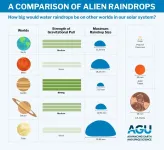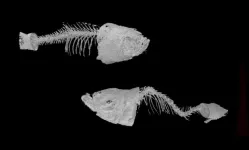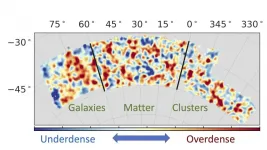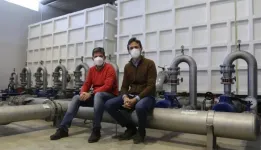A novel form of cellular logistics
2021-04-06
(Press-News.org) Biophysicists from Ludwig-Maximilians-Universitaet (LMU) in Munich have shown that a phenomenon known as diffusiophoresis, which can lead to a directed particle transport, can occur in biological systems.
In order to perform their biological functions, cells must ensure that their logistical schedules are implemented smoothly, such that the necessary molecular cargoes are delivered to their intended destinations on time. Most of the known transport mechanisms in cells are based on specific interactions between the cargo to be transported and the energy-consuming motor proteins that convey the load to its destination. A group of researchers led by LMU physicist Erwin Frey (Chair of Statistical and Biological Physics) and Petra Schwille of the Max Planck Institute for Biochemistry has now shown for the first time that a form of directed transport of particles can take place in cells, even in the absence of molecular motors. Furthermore, this mechanism can sort the transported particles according to their size, as the team reports in the latest issue of Nature Physics.
The study focuses on the MinDE system from the bacterium E. coli, which is an established and important model for biological pattern formation. The two proteins MinD and MinE oscillate between the poles of the rod-shaped cell and their mutual interaction on the cell membrane ultimately restricts the plane of cell division to the center of the cell. In this case, the researchers reconstructed the pattern forming MinDE system in the test-tube, using the purified Min proteins and artificial membranes. As expected from previous experiments, when the energy-rich molecule ATP was added to this system, the Min proteins recapitulated the oscillatory behavior seen in bacterial cells. More importantly, the experimenters went on to demonstrate that many different kinds of molecules could be caught up in the oscillatory waves as they traversed the membranes - even molecules that have nothing to do with pattern formation and are not found in cells at all.
A sorting machine for DNA origami
In order to analyze the transport mechanism in greater detail, the team turned to cargoes that consisted of DNA origami, and could be anchored to the membrane. This strategy allows one to create molecular structures of varying sizes and shapes, based on programmable base-pairing interactions between DNA strands. "These experiments showed that this mode of transport depends on the size of the cargo, and that MinD can even sort structures on the basis of their size," says Beatrice Ramm, a postdoc in Petra Schwille's department and joint first author of the new study. With the aid of theoretical analyses, Frey's group went on to identify the underlying transport mechanism as diffusiophoresis - the directed motion of particles along a concentration gradient. In the Min system, the friction between the cargo and the diffusing Min proteins is responsible for the transport of the freight. Thus, the crucial factor in this context is not a specific set of biochemical interactions - as in the case of transport via motor proteins in biological cells - but the effective sizes of the particles involved. "Particles that are more strongly affected by friction, owing to their large size, are also transported further - that's what accounts for sorting on the basis of size," says Andriy Goychuk, also joint first author of the paper.
With these results, the team has demonstrated the involvement of a purely physical (as opposed to a biological) form of transport based on diffusiophoresis in a biological pattern-forming system. "This process is so simple and fundamental that it seems likely that it also plays a role in other cellular processes, and might even have been employed in the earliest cells at the origin of life," says Frey. "And in the future, it might also be possible to make use of it to position molecules at specific sites within artificial minimal cells," he adds.
INFORMATION:
Nature Physics 2021
ELSE PRESS RELEASES FROM THIS DATE:
2021-04-06
The founding chair of the Biomedical Engineering Department at the University of Houston is reporting a new deep neural network architecture that provides early diagnosis of systemic sclerosis (SSc), a rare autoimmune disease marked by hardened or fibrous skin and internal organs. The proposed network, implemented using a standard laptop computer (2.5 GHz Intel Core i7), can immediately differentiate between images of healthy skin and skin with systemic sclerosis.
"Our preliminary study, intended to show the efficacy of the proposed network architecture, holds promise in the characterization of SSc," reports Metin Akay, John S. Dunn Endowed Chair Professor of biomedical engineering. ...
2021-04-06
WASHINGTON--Raindrops on other planets and moons are close to the size of raindrops on Earth despite having different chemical compositions and falling through vastly different atmospheres, a new study finds. The results suggest raindrops falling from clouds are surprisingly similar across a wide range of planetary conditions, which could help scientists better understand the climates and precipitation cycles of other worlds, according to the researchers.
Raindrops on Earth are made of water, but other worlds in our solar system have precipitation made of more unusual stuff. On Venus, ...
2021-04-06
As part of an international collaboration, researchers from ELTE Eötvös Loránd University developed a new animal model to study a rare genetic disease that can lead to blindness at the age of 40-50. The new model could open up new perspectives in our understanding of this metabolic disease and will also help to identify new potential drug candidates, according to the recent study published in Frontiers in Cell and Developmental Biology.
Pseudoxanthoma elasticum (PXE) is a rare genetic disease with symptoms that usually manifest in adolescence or in early adulthood. The symptoms are caused by the appearance of hydroxyapatite crystal deposits in the subcutaneous connective tissue and retina ...
2021-04-06
The universe is expanding at an ever-increasing rate, and while no one is sure why, researchers with the Dark Energy Survey (DES) at least had a strategy for figuring it out: They would combine measurements of the distribution of matter, galaxies and galaxy clusters to better understand what's going on.
Reaching that goal turned out to be pretty tricky, but now a team led by researchers at the Department of Energy's SLAC National Accelerator Laboratory, Stanford University and the University of Arizona have come up with a solution. Their analysis, published April 6 in Physical Review ...
2021-04-06
Nursing mothers who receive a COVID-19 vaccine may pass protective antibodies to their babies through breast milk for at least 80 days following vaccination, suggests new research from Washington University School of Medicine in St. Louis.
"Our study showed a huge boost in antibodies against the COVID-19 virus in breast milk starting two weeks after the first shot, and this response was sustained for the course of our study, which was almost three months long," said first author Jeannie Kelly, MD, assistant professor of obstetrics and gynecology. "The antibodies levels were still high at the end of our study, so the protection likely extends even longer."
Based ...
2021-04-06
Cells from individuals with Major Depressive Disorder (MDD) were found to have higher than expected rates of methylation at specific sites on their DNA, when compared to cells from healthy individuals without MDD, according to a study by a multidisciplinary team of UC San Francisco scientists, in collaboration with others. Methylation is a process by which DNA is chemically modified at specific sites, resulting in changes in the expression of certain genes. Methylation of particular sets of genes, called "DNA methylation clocks," typically change in predictable ways as people ...
2021-04-06
During the early phase of the pandemic, approximately 40% of the COVID-19 literature was shared as preprints - freely available manuscripts that are shared prior to peer-review. In a new study publishing in the open access journal PLOS Biology, researchers led by Dr Jonathon Coates (Queen Mary University of London), Dr Nicholas Fraser (Leibniz Information Centre for Economics, Germany) and Dr Liam Brierley (University of Liverpool) explore the crucial role of preprint servers in hosting COVID-19 related science and how these preprints have been used to disseminate knowledge of COVID-19, leading to cultural shifts in journalistic and policy practices.
There has been a rapid and incredible scientific response to the COVID-19 pandemic, with research ...
2021-04-06
Innovation and advances in technology have facilitated agricultural activity in recent years, as traditional irrigation techniques have been supplanted by pressure-basedones, improving water efficiency but increasing energy dependence. This drives up the Agriculture sector's energy costs, some of the highest in the European Union.
With the aim of increasing the energy efficiency of irrigation, researchers at the Hydraulics and Irrigation Group with the María de Maeztu Unit of Excellence,at the Department of Agronomy of the University of Cordoba (DAUCO), Juan Antonio Rodríguez Díaz and Jorge García Morillo, have field-tested a low-cost technology that takes advantage of the excess pressure on the grid to generate energy. This ...
2021-04-06
It is difficult to imagine our daily life without lithium-ion batteries. They dominate the small format battery market for portable electronic devices, and are also commonly used in electric vehicles. At the same time, lithium-ion batteries have a number of serious issues, including: a potential fire hazard and performance loss at cold temperatures; as well as a considerable environmental impact of spent battery disposal.
According to the leader of the team of researchers, Professor in the Department of Electrochemistry at St Petersburg University END ...
2021-04-06
Ambient air pollution is a global public health crisis, causing more than 4.9 million premature deaths per year around the world. In Africa, it has surpassed AIDS as the leading cause of premature death. According to one study, air pollution--specifically, fine particulate matter (PM2.5)--may cause at least as many as 780,000 premature deaths annually in Africa and worsen a significant number of diseases, including asthma, lung cancer, and chronic obstructive pulmonary disease.
Kinshasa, capital of the Democratic Republic of the Congo, and Brazzaville, capital of the Republic of Congo, are both large metropolises. However, neither Kinshasa (population 14. 3 million) nor Brazzaville (population 2.4 million) have had comprehensive air quality monitoring programs. ...
LAST 30 PRESS RELEASES:
[Press-News.org] A novel form of cellular logistics







